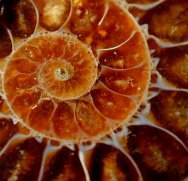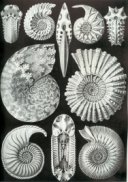Subclass Ammonoidea - Ammonites
Subclass
Ammonoidea
|
Of
related interest: | ||||||||||||||||||
 Ammonites
are an extinct marine taxon (subclass Ammonoidea) in the Phylum
Mollusca and Class Cephalopoda. Their closest living relative is
probably the modern nautilus that they closely resemble. Ammonite
fossil shells are of particularly beautiful
spiral forms, except for some more uncommon forms without spirals
that are called heteromorphs.
The name ammonite derives from the organism’s resemblance
to a coiled ram’s horn, after the god Ammon (that was depicted
as a man with ram's horns). Ammonites
are an extinct marine taxon (subclass Ammonoidea) in the Phylum
Mollusca and Class Cephalopoda. Their closest living relative is
probably the modern nautilus that they closely resemble. Ammonite
fossil shells are of particularly beautiful
spiral forms, except for some more uncommon forms without spirals
that are called heteromorphs.
The name ammonite derives from the organism’s resemblance
to a coiled ram’s horn, after the god Ammon (that was depicted
as a man with ram's horns). The
ammonite’s shell contained a spiraling progression of ever
larger chambers divided by thin walls called septa. The animal
only occupied the last and largest chamber. A thin living tube
called a siphuncle passed through the septa, extending from the
While the majority of ammonites have a shell that is a flattened coil, others have a shell that is partially uncoiled, partially coiled and partially straight (as in Australiceras), nearly straight (as in baculites and belemnites), or coiled helically - superficially like that of a large gastropod (as in Turrilites and Bostrychoceras). These partially-to-totally uncoiled forms appeared in the Lower Cretaceous and are known as heteromorphs. Ammonites first appeared in the late Silurian to early Devonian Periods (~400 million years ago) and became extinct at the close of the Cretaceous along with the dinosaurs (some 65 million years ago). They underwent repeated and large radiations only to fall victim to several extinction events. Ammonites were especially abundant in the Mesozoic marine environment due to rapid diversification, leading to widespread distribution, making them particularly useful to geologists and paleontologists as index fossils for biostratigraphy. Only some 10% of species survived the Permian Extinction, and their ultimate demise was alonside that of the dinosaurs in the K-T event that ended the Cretaceous Period. While the majority of ammonites have a shell that is a flattened coil, others have a shell that is partially uncoiled, partially coiled and partially straight (as in Australiceras), nearly straight (as in baculites and belemnites), or coiled helically - superficially like that of a large gastropod (as in Turrilites and Bostrychoceras). These partially-to-totally uncoiled forms appeared in the Lower Cretaceous and are known as heteromorphs.
|
|||||||||||||||||||
Fossil
Museum Navigation:
Home Geological Time Paleobiology Geological History Tree of Life Fossil Sites Fossils Evolution Fossil Record Museum Fossils |

